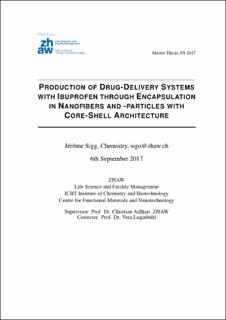Please use this identifier to cite or link to this item:
https://doi.org/10.21256/zhaw-2061| Publication type: | Master thesis |
| Title: | Production of drug-delivery systems with Ibuprofen through encapsulation in nanofibers and -particles with core-shell architecture |
| Authors: | Sigg, Jérôme |
| Advisors / Reviewers: | Adlhart, Christian Luginbühl, Vera |
| DOI: | 10.21256/zhaw-2061 |
| Extent: | 64 |
| Issue Date: | 2017 |
| Publisher / Ed. Institution: | ZHAW Zürcher Hochschule für Angewandte Wissenschaften |
| Language: | English |
| Subjects: | Electrospinning; Core-shell; Nanofibres; EHDA; Drugdelivery system; EHDA; Encopsulation; Coonial |
| Subject (DDC): | 615: Pharmacology and therapeutics |
| Abstract: | With the evolution of the high-trough-put screening (HTS) methods it is now possible to screen up to 100 000 pharmaceutical compounds each week and thus the amount of possible new active pharmaceutical ingredient (API) grow every week. Because of the fact that nearly half of the new API found today with the help of HTS have a low water solubility, electrohydrodynamic atomization (EHDA) can help to encapsulate these drugs for better bioavailability. As model drug Ibuprofen was used in this thesis, because Ibuprofen is one of the most used non-steroidal anti-inflammatory drugs (NSAIDs) and has a low water solubility. To enhance the bioavailability of Ibuprofen an encapsulation of it into nanoparticles and -fibers with core-shell architecture was done and the encapsulation and releasing efficiency was investigated. Three different and already well researched polymers, poly(-caprolactone) (PCL), poly(vinyl alcohol) (PVA) and poly(vinyl pyrrolidone) (PVP), were used to encapsulate Ibuprofen into coaxial nanofibers. With PVA fibers a theoretical drug loading of 64 wt% was achieved and after 7 h 23% of the theoretical Ibuprofen amount was released, with a burst release of 20% after one hour. The PVP fibers could be loaded with 22 wt% of Ibuprofen and they released all of the, from the flow rates calculated, Ibuprofen after 20 h, so they showed a high encapsulation efficiency and a slow release rate, with only releasing 28% after one hour. With PCL as shell polymer two different types of coaxial fibers were produced, one with a core only made of Ibuprofen and the other with a PVP and Ibuprofen core. The first one released 100% of the theoretical Ibuprofen amount after 20 h with burst releases of 66% to 76% after one hour and drug loadings of 30 wt% to 50 wt% Ibuprofen into the fibers, in dependence of the PCL concentration used. The latter one had drug loadings of 19 wt% to 26 wt%, also in dependence of the used PCL concentration, and releases of 77% to 89% after 20 h and after one hour burst releases of 26% to 77% were achieved. With the PCL fibers and the PVP fibers one could achieve a covering of the therapeutic window of Ibuprofen over a time span of 8 h, in comparison to 2 h with commercially available tablets. Furthermore with the combination of the fast releasing PVA fibers and the slowly releasing PCL one could also cover the therapeutic window from the first hour on. |
| URI: | https://digitalcollection.zhaw.ch/handle/11475/1869 |
| License (according to publishing contract): | Not specified |
| Departement: | Life Sciences and Facility Management |
| Appears in collections: | Masterarbeiten Life Sciences |
Files in This Item:
| File | Description | Size | Format | |
|---|---|---|---|---|
| 2017_Sigg_Jérôme_MA_MScLS_CLS.pdf | 10.99 MB | Adobe PDF |  View/Open |
Show full item record
Sigg, J. (2017). Production of drug-delivery systems with Ibuprofen through encapsulation in nanofibers and -particles with core-shell architecture [Master’s thesis, ZHAW Zürcher Hochschule für Angewandte Wissenschaften]. https://doi.org/10.21256/zhaw-2061
Sigg, J. (2017) Production of drug-delivery systems with Ibuprofen through encapsulation in nanofibers and -particles with core-shell architecture. Master’s thesis. ZHAW Zürcher Hochschule für Angewandte Wissenschaften. Available at: https://doi.org/10.21256/zhaw-2061.
J. Sigg, “Production of drug-delivery systems with Ibuprofen through encapsulation in nanofibers and -particles with core-shell architecture,” Master’s thesis, ZHAW Zürcher Hochschule für Angewandte Wissenschaften, 2017. doi: 10.21256/zhaw-2061.
SIGG, Jérôme, 2017. Production of drug-delivery systems with Ibuprofen through encapsulation in nanofibers and -particles with core-shell architecture. Master’s thesis. ZHAW Zürcher Hochschule für Angewandte Wissenschaften
Sigg, Jérôme. 2017. “Production of Drug-Delivery Systems with Ibuprofen through Encapsulation in Nanofibers And -Particles with Core-Shell Architecture.” Master’s thesis, ZHAW Zürcher Hochschule für Angewandte Wissenschaften. https://doi.org/10.21256/zhaw-2061.
Sigg, Jérôme. Production of Drug-Delivery Systems with Ibuprofen through Encapsulation in Nanofibers And -Particles with Core-Shell Architecture. ZHAW Zürcher Hochschule für Angewandte Wissenschaften, 2017, https://doi.org/10.21256/zhaw-2061.
Items in DSpace are protected by copyright, with all rights reserved, unless otherwise indicated.